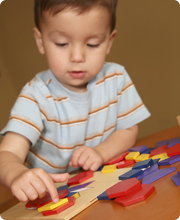Toys and Play: 1- and 2-Year-Olds
You can download this article as a PDF (English, Spanish)
 Children play from the moment they are born. Play is how they learn about themselves and their world. It is how they develop and practice the physical, thinking and social skills needed in life. These tips will help you choose toys and play activities for your child based on their age or stage of development. Think about sharing them with your child’s other caregivers, too
Children play from the moment they are born. Play is how they learn about themselves and their world. It is how they develop and practice the physical, thinking and social skills needed in life. These tips will help you choose toys and play activities for your child based on their age or stage of development. Think about sharing them with your child’s other caregivers, too
How 1- and 2-Year-Olds Play
1-year-olds and young toddlers:
- Are curious and test things out
- Play mostly alone
- Like to dump, push and pull, turn, knock down, stack things up, empty and fill
- Begin to copy adult actions like housecleaning, caretaking and cooking, etc.
- Enjoy being read to
- Like to climb and may manage small indoor steps
2-year–olds:
- Enjoy active play
- Climb, roll, gallop, somersault
- Group and match toys that are alike
- Kick and catch larger balls
- Throw and retrieve objects
- Push self on wheeled toys
- Enjoy texture, shape, size and color of objects
Toys and Activities
Active toys
- Push-and-pull toys on a short string (for steady walkers)
- Simple doll stroller
- Small rocking horse
- Low, soft climbing platforms
- Tunnels for crawling
- Low slides with handrails
- Large, light and soft balls with visual effects, noises and movement
For older toddlers:
- Toy versions of adult tools such as vacuum, shopping cart, wagon, light wheelbarrow
- Spinning seat
- Ride-on toys that move by pushing with feet (no steering device)
- Small tricycle with helmet (from about 2½ to 3 years)
Manipulative toys
- Large, hollow building blocks made of cardboard or plastic
- Activity boxes with lids, doors, knobs and dials
- Simple pop-up toys
- Nesting cups
- Shape sorters
- Peg boards with large pegs
- Pounding and hammering toys
- Jumbo, colored lacing beads
- Board books
For older toddlers:
- Solid wooden blocks
- Plastic rings that connect, large plastic nuts and bolts
- Large, plastic bricks or blocks that connect
- Lacing cards or cubes
Puzzles
- Pre-puzzles with 2 to 3 pieces
- Three to 5 pieces with knobs (from about 1½ years)
- Four to 5 pieces (from 2 to 2½ years)
- Six to 12 pieces (2½ to 3 years)
Sand and water play
- Simple floating toys
- Small shovel and pail
- Bathtub activity centers
- Funnels, colander and sand mill
Make-believe toys
- Toy phone and simple housekeeping toys
- Simple dress-up clothes
- Child-sized stove/oven, fridge, table and chairs (large boxes work well)
- Dolls and stuffed animals
- Doll blanket, bottle and bed
- Small hand or finger puppets
- Play sets (farm, garage, airport)
- Push or pull cars and large trucks (not metal)
- Simple trains (1 to 2 cars)
- Bells, rattles, cymbals, drums, triangle and sand blocks
Arts and Crafts
- Large crayons and markers
- Play-Doh (2 years and older)
- Sturdy, large paper
Safety
Choose toys that meet these safety guidelines for this age:
- Non-toxic materials
- No sharp points or edges
- Non-breakable
- No small parts that can get stuck in throat, ears or nose
- No parts that could trap fingers, toes or hands
- No electrical parts
- No glass or brittle plastic
- Balls and toys should be large enough that they can’t be swallowed when squashed down
- No exposed pins, sharp wires or nails
- Don’t allow children to play with toys that have miniature disk or “button” batteries that can be removed easily
Learn more about toy safety and get tips for choosing toys and play activities for children of other ages.
